Kitesurfing in Maui: An Essential Guide
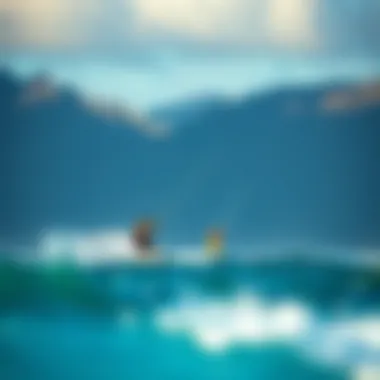
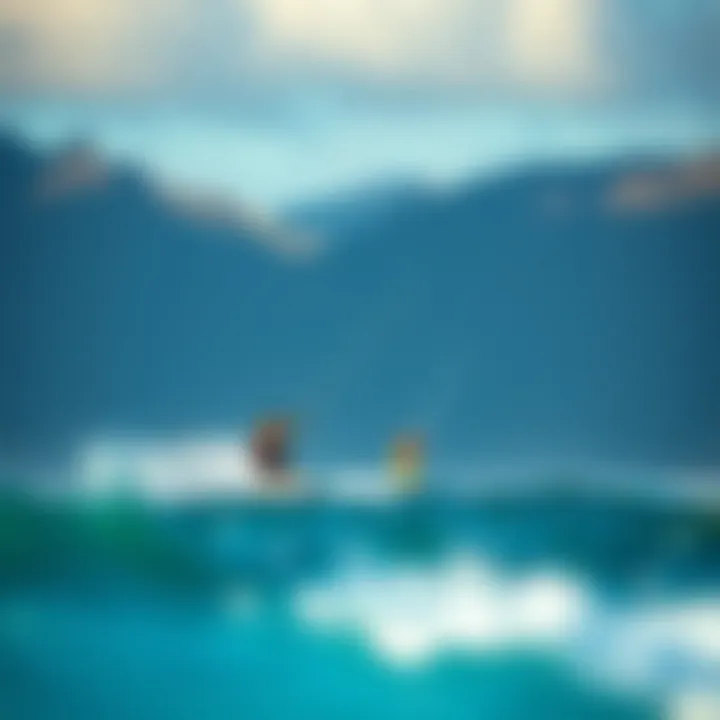
Gear Selection
When it comes to kitesurfing in Maui, the right gear can make all the difference. The combination of wind patterns, water conditions, and individual skill levels dictates the optimal types of equipment. Selecting your gear wisely can transform an ordinary experience into one that's exhilarating.
Types of Kites
A variety of kite types exist, tailored to different conditions and rider preferences. For Maui, where the winds can be variable, understanding your options is crucial.
- Hybrid Kites: These are versatile and work well in different wind conditions. They’re a favorite for those who want to ride across various spots on the island.
- SLE (Supported Leading Edge) Kites: Excellent for beginners largely due to their stability and power. They teach the basics smoothly, which is beneficial when tackling Maui’s windy spots.
- C Kites: While more advanced, these kites excel in strong winds and give riders a direct, responsive feel. Riders looking to perform tricks might lean towards these for their superior maneuverability.
Choosing the right kite depends on both skill level and the specific conditions of the day. Wind strength and the nature of the water you’re navigating are significant factors here.
Choosing the Right Board
The board is just as vital in this equation as the kite itself. With different shapes and sizes available, the board you decide on will influence your ride immensely.
- Twin Tip Boards: Suitable for most riders, these boards are perfect for both beginners and experienced kitesurfers. They allow for riding in both directions, making them a flexible choice on Maui.
- Directional Boards: These boards resemble surfboards and are ideal for wave riding. If tackling Maui’s waves is on your agenda, a directional board might be just what you need.
- Foil Boards: A newer introduction to the scene, foil boards let you ride above the water’s surface which provides a unique experience. This can be fantastic for gliding smoothly over choppy waters.
The right board enhances performance and comfort, so making an informed choice is key.
Skill Development
Understanding the gear is only the tip of the iceberg; skill development plays an equally important role in your kitesurfing journey. As you venture on the vibrant waters of Maui, continually refining your techniques will make your time spent on the waves more enjoyable and productive.
Essential Techniques
For those starting out, mastering basic techniques is paramount. Without a solid foundation, it’s easy to feel overwhelmed. Here are some essential techniques:
- Body Dragging: This technique helps a kitesurfer become familiar with the water and kite dynamics. It teaches control during less intense sessions before moving on to more complex maneuvers.
- Water Starts: Once you’re comfortable with body dragging, the next step is starting from the water. Practicing this will give you the confidence needed to stand up and ride.
- Turning and Jibing: As you advance, learning to change directions efficiently will make your experience smoother. This involves a combination of steering the kite and shifting weight on the board.
Progression Tips
Moving beyond the basics requires patience and a few strategic approaches. Here are some thoughts on how to progress:
- Practice Regularly: Regular sessions witll help reinforce what you've learned. Kitesurfing is all about muscle memory, so consistent practice is essential.
- Take Lessons: Even if you feel confident, an instructor can provide guidance that fast-tracks your learning and helps you avoid common pitfalls.
- Observe Experienced Riders: Watching others can be incredibly insightful. You might pick up tricks or techniques that are hard to learn in a textbook.
Maui's coastline is rich with opportunities for growth, making it a perfect place to hone skills.
"In kitesurfing, every session becomes a novel—filled with experiences unique to each rider. What lessons will you write on the waves?"
With the right gear and a focus on developing your skills, kitesurfing in Maui offers a memorable adventure that beckons enthusiasts of all levels.
Prelude to Kitesurfing
Kitesurfing, also known as kiteboarding, combines aspects of surfing, windsurfing, and paragliding. This sport harnesses the power of the wind through a large kite, pulling the rider across the water on a board. The beauty of kitesurfing lies not only in its thrilling nature but also in the stunning landscapes where it’s practiced. In Maui, this sport has flourished, attracting both seasoned professionals and curious newcomers alike.
Kitesurfing is not just about excitement; it offers physical benefits like improved coordination, strength, and balance. It can also be a fantastic way to connect with nature and find peace on the water. Riders often describe a unique sense of freedom while soaring over the waves, making it a compelling choice for those looking to escape the grind of daily life.
Why It Matters
Understanding kitesurfing is crucial for anyone looking to explore this sport thoroughly. Knowing its features, benefits, and the equipment used lays the groundwork for a safe and enjoyable experience. This article will take you through the history, comparison with other water sports, and much more, ensuring that both newbies and veterans find valuable insights.
"Kitesurfing may challenge your skills, but in return, it gifts you with exhilarating rides and unforgettable memories."
The journey into kitesurfing offers a diverse view into a lifestyle that combines adventure, community, and a deep respect for nature. As we move forward, we’ll dissect the evolution of this sport, comparing it with others that share the water with it.
Why Maui?
Maui, often dubbed the "Valley Isle," stands out not just for its majestic landscapes but also because of its prime conditions for kitesurfing. With warm waters, consistent winds, and breathtaking views, Maui has become a favored destination for kiteboarders from around the world. The appeal of this tropical paradise goes beyond just the thrill of the sport; it encompasses a lifestyle that resonates with those who cherish adventure and connection to nature. Kitesurfing in Maui is not merely an activity; it's an experience that intertwines skill, excitement, and community.
Geography and Climate
Maui’s geography plays a vital role in creating the perfect kitesurfing environment. The island features a mix of lush mountains and sandy beaches which help to channel winds beneficial for riders. Notably, the trade winds, blowing predominantly from the northeast, seem to create a symphony of ideal conditions almost year-round. The average wind speed ranges from 15 to 25 knots, providing enough power for riders without being overwhelming.
- Wind Pattern: The trade winds are particularly strong between May and September, making this period the peak season for kitesurfing.
- Water Conditions: The waters around Maui vary, with locations offering flat water, perfect for beginners, and more challenging waves for the experienced.
- Temperature: The pleasantly warm waters hover around 70 to 80 degrees Fahrenheit, allowing for longer sessions without the need for a thick wetsuit.
Navigating these natural settings, one finds that each kitesurfing spot offers a unique experience, whether it be the broad beaches of Kanaha or the swells at Hookipa. Maui’s cohesive geography contributes to a vibrant ecosystem; it’s not uncommon to see sea turtles glide below while you’re practicing jumps or dips.
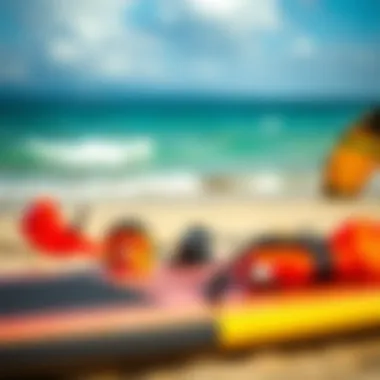
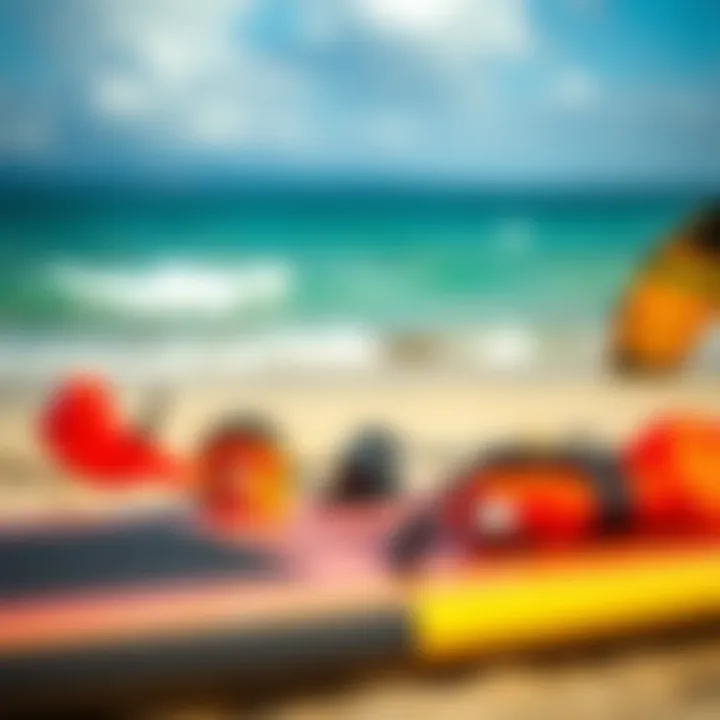
Cultural Significance of Water Sports
Kitesurfing has woven itself not just into Maui’s landscape, but also into its cultural fabric. The Hawaiian Islands boast a rich history linked to water sports, often celebrating their connection to the ocean and wind. In Maui, kitesurfing appeals to both locals and tourists, creating a sense of community among those who ride the waves.
- Integration of Traditions: Water sports are celebrated here, reflecting the Hawaiian philosophy of respect for nature and the elements. Activities such as surfing, stand-up paddleboarding, and kitesurfing share a common thread of harmony with the ocean.
- Celebrating Competitions: Maui hosts various kitesurfing competitions and local events, drawing participants and spectators alike. This not only promotes the sport but also emphasizes camaraderie among riders.
"In Maui, we aren’t just riding on the water; we embrace the ocean as part of who we are. It’s a way of life, not just a sport."
The community around kitesurfing encourages riders to share knowledge and experiences, enhancing the learning curve for newcomers while fostering a respectful environment for all levels. This cultural significance adds depth to the kitesurfing experience in Maui, turning it into an essential element of social interactions on the island.
Ultimately, the combination of Maui’s geographic advantage and its cultural embrace of water sports creates an inviting atmosphere for all those eager to ride the wind and waves. Kitesurfing here is elevated to an art form, reflecting both personal style and a collective passion for the ocean.
Best Kitesurfing Spots in Maui
When it comes to kitesurfing in Maui, the locations you choose make all the difference. Each spot offers unique features that cater to different levels of experience, preferences, and conditions. Understanding these locations aids both newcomers and seasoned riders in maximizing their experience on the water. Let’s take a closer look at some of the best kitesurfing spots Maui has to offer.
Kanaha Beach Park
Kanaha Beach Park is often the starting point for many kitesurfing beginners. Located near the Kahului Airport, it boasts spacious sandy areas and a consistent trade wind, making it an inviting place for those just finding their footing in the sport. The diverse crowd here ranges from first-timers learning the ropes to advanced riders enjoying exhilarating sessions.
One of the standout features of Kanaha is the gradual depth of the water. This makes it safer for novices who are getting familiar with kite control. Additionally, the east-facing beach means that kitesurfers can take advantage of the reliable winds blowing from the northeast. During favorable times, the conditions can even be ideal for freestyle tricks too, offering a little something for everyone.
"Kanaha is not just a spot; it's a community for budding kitesurfers. The vibe here is encouraging and uplifting!"
Hookipa Beach
Hookipa Beach is a world-renowned location that is revered by experienced kitesurfers for its larger waves and more challenging conditions. Just a short drive from Kanaha, this beach attracts an adventurous crowd seeking thrill rather than comfort. The winds here are often stronger, which appeals to those looking to push their skills to the limits.
In addition to its strong winds, Hookipa is famous for its picturesque scenery, with stunning cliffs surrounding the beach and lush greenery lining the shore. The atmosphere is vibrant, drawing not only kitesurfers but also surfers and windsurfers, creating a lively beach environment. However, this spot might not be the best for beginners due to the strong currents and wave action. Those wanting to ride at Hookipa should be confident in their abilities and aware of local conditions.
Kihei Shores
For those looking for a more laid-back experience, Kihei Shores presents itself as a suitable option. The beach tends to be less crowded than the previous spots, making it ideal for individuals who prefer a more relaxed atmosphere. Kihei is known for its warm, inviting waters that are perfect for all skill levels, allowing for a more personal experience while kitesurfing.
The wind conditions here can be less predictable compared to Kanaha and Hookipa, but when the winds are in favor, it offers a beautiful ride along the shoreline. The gentle waves and soft sand create a perfect playground for practicing tricks, or simply enjoying the ride. This spot also provides an excellent opportunity to soak in the scenic beauty without the hustle and bustle that may be present at busier beaches.
Equipment for Kitesurfing
When it comes to kitesurfing, the equipment you choose can significantly affect your overall experience on the water. This sport, combining elements of surfing and flying, requires a unique set of gear tailored to the wind and water conditions you're likely to encounter in Maui. Making informed choices about your equipment ensures not only efficient performance but also your safety and enjoyment while riding the waves.
Choosing the Right Kite
Selecting the perfect kite involves understanding various factors, including wind conditions, your skill level, and personal preference. Kites come in different shapes and sizes, each designed to handle diverse situations.
- Size Matters: The size of your kite should be chosen based on the wind speed. For lighter winds, larger kites work well, helping to lift you off the water smoothly. Conversely, stronger winds call for smaller kites to maintain control. If you're just starting out, many opt for a 9- or 10-meter kite for a balance of power and maneuverability.
- Kite Design: Kites are generally classified into two designs: C kites and bow kites. C kites are known for their powerful pull and are a favorite for experienced riders seeking high jumps. Meanwhile, bow kites provide more stability and are considered great for beginners. It's wise to test both types to determine which feels right for your style.
- Material Quality: Pay attention to the construction materials. A durable and lightweight fabric, like ripstop nylon, will enhance your kite’s longevity while withstanding the salty waves and wind.
"A well-chosen kite is like a trusted friend; it becomes an extension of your own skills on the water."
Boards: Types and Functions
The board you choose is just as essential as your kite. They come in several varieties, each tailored for specific styles and conditions. Here are the main types:
- Directional Boards: Best for wave riding, these boards allow for a surfing stance. They’re a bit less popular for beginners but amazing for advanced riders looking to shred the waves.
- Twin-Tip Boards: These are symmetrical, making them more versatile. You can ride them in either direction, which makes them perfect for tricks and jumps. Most beginners start here because of their user-friendly design.
- Foil Boards: If you're looking to explore something a bit different, consider foil boards. They lift above the water surface, giving you a sensation akin to gliding, which is quite different from traditional riding.
Safety Gear Essentials
Safety should always be a priority when kitesurfing. Equipped with the right safety gear, you can mitigate risks while enhancing your riding experience. Here are some must-haves:
- Harness: Opt for a comfortable harness that fits well. There are seat harnesses and waist harnesses; each has its own pros and cons. A good harness distributes the pull from the kite accurately to help lessen strain on your back.
- Helmet: A helmet is non-negotiable, particularly for beginners. You’re sometimes learning in unpredictable conditions, and protecting your head is vital.
- Impact Vest: Consider wearing an impact vest, especially when learning jumps. This vest provides additional protection and buoyancy, which is beneficial if you fall.
- Safety Leash: Ensure your kite is equipped with a safety leash. This device keeps your kite attached to you, minimizing its ability to fly away uncontrollably if you fall.
- Personal Flotation Device (PFD): While kitesurfing, having a PFD can be a lifesaver, especially in choppy waters. Some vest models are designed specifically for kitesurfing, providing safety without hindering your movements.
In summary, the equipment you choose for kitesurfing plays an integral role in how enjoyable and safe your experience will be. Whether you're navigating the gentle breezes of Kanaha Beach Park or tackling the waves of Hookipa Beach, having the right gear can make all the difference in enhancing your time on the water.
Safety Considerations
Engaging in kitesurfing presents numerous thrills, but safety must sit atop your priority list. When you’re harnessed to a kite and zipping across the waves, understanding safety considerations can be the difference between a fantastic day on the water and an unfortunate mishap.
Understanding Wind Conditions
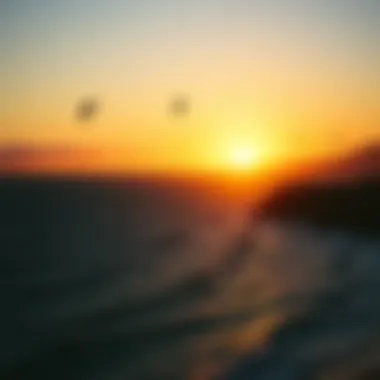
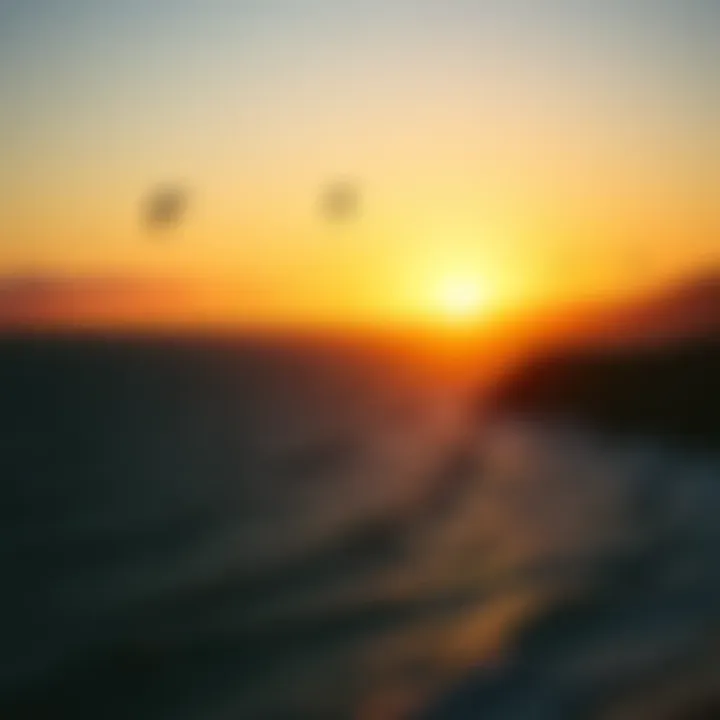
One of the pivotal elements in kitesurfing safety is the wind. Mastering wind conditions isn't just about reading a forecast; it requires familiarity with local patterns and how they might affect your ride. Winds can change without notice, so keeping an eye on the water and the skyline is crucial.
- Local Wind Zones: Maui features specific wind zones, often referred to by kitesurfers as reliable spots. For instance, the trade winds are a consistent presence; however, they can shift unexpectedly in different areas around the island. Conditions at Kanaha Beach can differ substantially from those at Hookipa.
- Wind Speed Recommendations: As a rule of thumb, novices should stay within a wind speed of 10-20 knots, while advanced riders may handle higher velocities. It’s key to understand your own limits alongside the wind’s temperament.
- Wind Shadow Areas: Watch out for wind shadow areas, where buildings, hills, or other obstacles absorb or deflect the wind. These spots can create unpredictable turbulence which can catch you off guard.
As a safety practice, consider carrying a handheld anemometer to measure wind speed when venturing into unfamiliar territory. It’s just one piece of equipment that can provide peace of mind.
Local Regulations and Practices
Navigating local regulations and practices not only ensures your own safety but also protects the environment and the community. In any new setting, understanding the rules is paramount, and Maui is no exception.
- Kiting Zones: Not all beaches allow kitesurfing, hence knowing which areas are designated kiting zones—like Kanaha Beach Park—is essential. Ignoring these guidelines could lead to conflicts with beachgoers or even legal actions.
- Right of Way: Kitesurfers should be well-versed in the right-of-way rules. Generally, downwind riders have priority; this helps in avoiding collisions.
- Respecting Wildlife: Maui's waters are home to unique marine life. Riders should be careful near reef areas or during breeding seasons for local species. Keeping a respectful distance from wildlife not only keeps you safe but also helps preserve this beautiful ecosystem.
Always take a few moments to familiarize yourself with both the atmosphere around you and the existing guidelines before hitting the water.
Following these safety considerations while kitesurfing in Maui will help you enjoy the sport to its fullest while minimizing risks. By making informed choices about wind conditions and adhering to local regulations, you contribute to a positive community that values both adventure and safety, keeping the spirit of kitesurfing alive for everyone.
Lessons and Training
Kitesurfing, while exhilarating, demands a solid foundation in skills and safety protocols. This is where lessons come into play, serving as the crucial first step for beginners and as a valuable refresher for seasoned riders. Training helps in mastering the art of handling the kite and board, understanding the wind patterns, as well as learning vital safety measures. For those aiming to explore Maui's stunning coastlines while kitesurfing, enrolling in a proper training program can enhance the experience tremendously and, more importantly, ensures that one rides the waves with confidence.
Finding a Kiteboarding School
Maui boasts a variety of kiteboarding schools catering to different skill levels. Whether you’re a newbie or looking to perfect your jumps, there’s a place for you. A few aspects to consider when selecting a school include:
- Reputation: Look for schools with positive reviews and well-trained instructors. Ask around in local forums or check platforms like Reddit and Facebook for recommendations.
- Location: Picking a school situated near popular kitesurfing spots like Kanaha Beach or Hookipa can save time and allow for more practical experience.
- Instructor Qualifications: Ensure the school employs instructors with proper certifications, preferably affiliated with recognized kiteboarding organizations.
These factors contribute to a more effective learning experience, helping you progress quickly and safely.
Private vs. Group Lessons
When it comes to lessons, the choice between private and group sessions often arises. Each has its set of advantages, and understanding these can lead to better decision-making based on your personal goals.
- Private Lessons:
For those who prefer undivided attention, private lessons provide an opportunity for personalized teaching. This format allows:
- Customized lesson plans tailored to individual needs.
- Faster progression due to the instructor’s full focus.
- Flexibility in scheduling according to your convenience.
However, this option can be pricier.
- Group Lessons:
On the flip side, group lessons can be a fun and social way to learn. Some pros include:
- Cost-effectiveness, as prices are often lower than private sessions.
- The chance to meet other kitesurfers, building a network of friends and fellow enthusiasts.
- Observing others can offer insights into techniques and styles that you may want to incorporate into your own practice.
Consider factors like your learning style, budget, and goals when making this decision.
Remember: Whichever option you choose, proper training not only enhances skill but also helps in fostering respect for the marine environment, ensuring a safer, more enjoyable kitesurfing experience for everyone involved.
The Kitesurfing Community in Maui
The kitesurfing community in Maui is not just a collection of individuals sharing a common passion; it represents a tight-knit network of enthusiasts, instructors, competitors, and advocates committed to the sport and the well-being of their environments. More than mere participants, the riders of Maui are a vibrant blend of cultures, bringing diverse experiences that only enhance the kitesurfing experience on the island.
This community acts as an essential pillar for those new to the sport, providing vital knowledge, opportunities for collaboration, and a welcoming atmosphere that encourages skills growth. For those who wish to dive headfirst into kitesurfing—be it through lessons, local events, or informal meet-ups—understanding the heart of this community is crucial.
"Finding friendship among the waves can be just as exhilarating as the ride itself."
Local Events and Competitions
Maui hosts many events and competitions that bring together kitesurfers from various backgrounds. These events serve as platforms for riders to showcase their skills, with competitions often designed to cater to different levels of expertise. The atmosphere at these gatherings is electric; participants vibe off each other's energy, creating a sense of camaraderie that’s hard to replicate elsewhere.
Some noteworthy events include:
- The Maui Kitesurfing Competition: A prestigious annual event that draws the best talent from around the world to compete in thrilling races.
- Local Beach Clean-Up Events: These gatherings strikingly show the community's commitment to protecting the beautiful landscapes that kitesurfers enjoy. Riders come together not just to compete but also to give back to the environment and foster a sustainable kitesurfing experience.
- Workshops and Clinics: Regularly organized skill-building clinics led by experienced riders offer opportunities to learn and improve in a communal setting.
The spirited nature of the events allows for spectators and newcomers to witness the thrill of kitesurfing firsthand, providing an open invitation to join the ranks of passionate riders.
Building Connections with Fellow Riders
One of the beautiful facets of the kitesurfing community in Maui is the opportunities for building connections with fellow riders. When you hit the water, it often feels like you’re part of a family—everyone cheering for one another and sharing knowledge openly. This spirit of community can be remarkable for newcomers who may feel intimidated at first. By attending local meet-ups, joining social media forums, or simply striking up conversations at the beach, newcomers can find supportive mentors eager to help hone their skills.
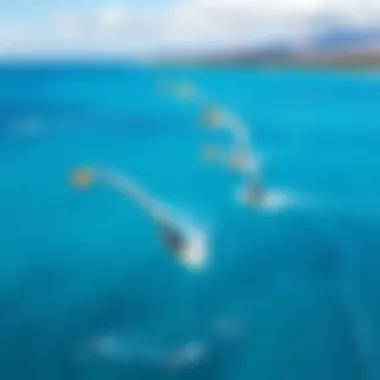
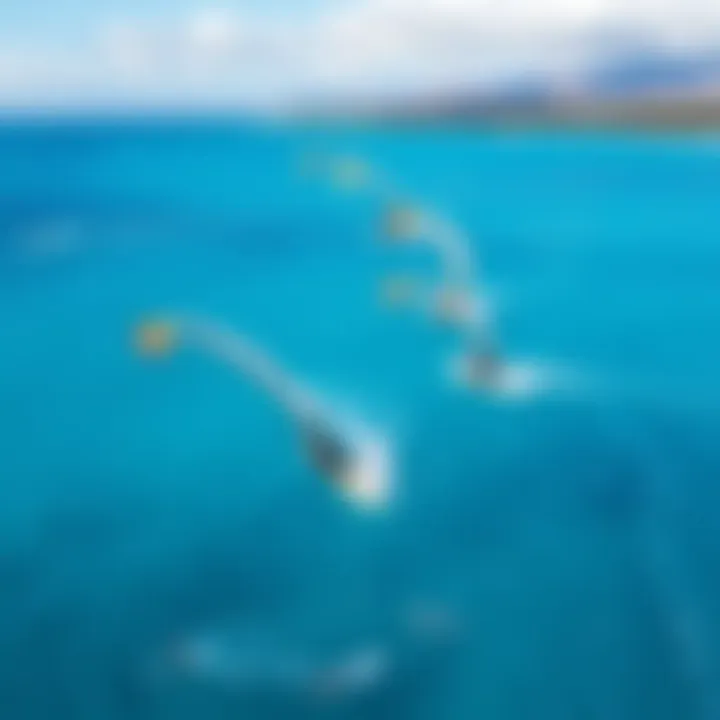
The connections formed here often go beyond kitesurfing. Riders frequently become friends, exploring the island together, sharing tips about spots, equipment, and local conditions. For instance, local Facebook groups can serve as excellent platforms for finding riding partners, arranging travel plans for competitions, and sharing insights about the best conditions of the day.
Additionally, engaging in local traditions, like attending luaus or surf contests, adds layers to the friendships formed. The personal connections created can lead to long-lasting bonds that transcend the sport itself. In essence, the kitesurfing community on Maui transforms mere riders into lifelong friends who share experiences out of the water too.
Links for more information:
- Maui Kitesurfing Events on Facebook
- Kitesurfing Local Competitions
- Wikipedia on Kitesurfing
- Eco-Friendly Practices
Through these connections and shared experiences, the community enhances the overall kitesurfing adventure in Maui, making it a truly enriching experience.
Environmental Considerations
Kitesurfing is undoubtedly an exhilarating experience, but with every wave and gust of wind, there are important environmental considerations that need to be addressed. In this section, we will dive into how kitesurfing interacts with the delicate ecosystems of Maui, the potential impacts on marine life, and methods to engage in this sport responsibly while preserving the beauty of the island.
Impact of Kitesurfing on Marine Life
The waters surrounding Maui are rich in biodiversity, adorned with vibrant coral reefs and a multitude of marine species, from the majestic turtles to colorful fish. As kitesurfing gains popularity, it becomes essential to discuss the way this sport affects these vulnerable ecosystems.
First and foremost, kitesurfing can potentially disturb habitats. The presence of kites and boards in the water can impact feeding and breeding behaviors of marine creatures. For instance, when boarders glide over sensitive coral areas, they risk damaging fragile ecosystems that take years to recover. It’s crucial to steer clear of such locations for the sake of our underwater friends.
Moreover, interaction with marine life is another aspect to consider. During your kitesurfing sessions, it’s common to encounter sea turtles or various fish species. Approaching them might seem harmless, but it's important to maintain a respectful distance. That way, we don’t inadvertently contribute to stress or habitat disruption for these creatures.
"Protecting our marine life while enjoying kitesurfing is a right of passage for every rider. Awareness is key; it keeps the sport alive and blooming for future generations."
Promoting Eco-Friendly Practices
As kitesurfers, we have a stewardship role in safeguarding the natural beauty of Maui. Employing eco-friendly practices not only preserves the locale but enriches our kitesurfing experience. Here are a couple of ways to tread lightly:
- Use biodegradable materials: Opt for kites and boards made from eco-conscious materials. Brands like Slingshot or Duotone have started to produce equipment with a focus on sustainability.
- Educate fellow riders: Share knowledge about the ecological importance of respecting marine life. Create a culture of awareness within the kitesurfing community, such that every new rider learns about the balance between fun and environmental responsibility from the get-go.
- Participate in clean ups: Taking part in beach clean-ups or organizing such activities can significantly impact the environment and community sentiment. It’s not only cathartic but also builds camaraderie among locals and tourists alike.
- Spread the word: Use social media platforms to highlight environmentally friendly practices or initiatives. Let your followers know why protecting the ocean matters, employing appealing visuals and engaging narratives.
In summary, kitesurfing can harmonize with environmental stewardship. When we ride the winds atop our boards, let's remember we share the ocean with countless creatures who depend on it. By embracing eco-friendly practices, we can enjoy kitesurfing on Maui while ensuring that its wonders are here for generations to come.
Emerging Trends in Kitesurfing
As kitesurfing continues to carve out its niche in the realm of water sports, staying abreast of the emerging trends becomes essential. The landscape of kitesurfing is ever-evolving, influenced by innovation in technology, shifts in community engagement, and the growing importance of environmental consciousness. Such trends not only shape the experience of kitesurfers but also push the boundaries of the sport itself. Engaging with these changing tides provides insight into what may lie ahead for both newcomers and veterans alike.
Technological Advancements in Equipment
The leaps in technology have transformed kitesurfing equipment into finely-tuned instruments that enhance performance and safety. Modern kites are lighter and more durable, often incorporating materials like ripstop nylon and composite foams, which help withstand the rigors of intense conditions.
For example, brands like Cabrinha and Slingshot have developed kites with advanced aerodynamic designs, allowing for better control in gusty winds. Riders now have access to adjustable bar setups and depower features that give them flexibility during their sessions. New board designs are focusing on versatility, offering shapes that cater both to freestyle and wave riding, accommodating a wider array of skill sets.
In addition, GPS technology and smart sensors are increasingly integrated into kitesurfing gear. This tech not only offers real-time data on speed and distance but also helps to monitor conditions in the ocean, which is vital for ensuring a rider's safety. Such advancements foster not only a personalized experience but also contribute to an overall safer environment on the water, thus enhancing enjoyment and skill development.
The Role of Social Media in the Sport
Social media has carved out a significant role in connecting kitesurfers globally. Platforms like Instagram and TikTok have become virtual hubs for sharing experiences and skills. Riders can showcase their best tricks, techniques, and travel adventures, inspiring others to join the fold. The visual nature of these platforms lends itself well to the captivating dynamics of kitesurfing, with videos often going viral and captivating attention far beyond local communities.
The rise of online communities has been transformative. In forums and groups, kitesurfers share tips, local weather conditions, and organize meetups for sessions or competitions. For instance, Reddit hosts numerous threads where cyclists share gear reviews and even mentor newcomers. Meanwhile, trending hashtags allow users to follow kitesurfing events, pushing participation and attendance to newer heights.
Social media not only enhances the visibility of kitesurfing but also plays a role in advocating for environmental conservation as riders share how they can minimize their impact on marine ecosystems.
"The fusion of technology and social networking is redefining kitesurfing, providing avenues for innovation and community building like never before."
Ending
The concluding remarks of this guide shine a light on the vital aspects that define kitesurfing in Maui, making it a unique experience for both newcomers and seasoned riders. Understanding the future of kitesurfing, along with embracing the lifestyle it brings, serves as a cornerstone of the sport's evolution.
Future of Kitesurfing in Maui
Kitesurfing in Maui holds a promising future as the sport continues to grow beyond its humble beginnings. One aspect worth pondering is the role of technology in shaping experiences. Not only are kites becoming more advanced, with features designed for enhanced safety and greater maneuverability, but also the use of wearable devices and apps can help riders track their progress more effectively.
Additionally, the local scene is becoming increasingly supportive of eco-friendly practices. There are emerging initiatives focusing on sustainability that encourage riders to be mindful of their environmental impact. This can be significant for Maui’s delicate marine ecosystems, which many kitesurfers cherish.
Moreover, the advent of virtual communities is reshaping how enthusiasts connect. Social media platforms allow riders to share their experiences, tips, and even challenges, creating a global network that enriches the kitesurfing culture. Local and international competitions also add to the excitement, drawing crowds and inspiring new generations to take up the sport. It’s a vibrant tapestry of spirits rising with the winds.
Embracing the Kitesurfing Lifestyle
For many, kitesurfing isn’t simply a hobby—it's a way of life. To truly embrace this lifestyle, one must immerse in the culture that comes with it. Becoming part of the kitesurfing community in Maui means more than just hitting the waves. It involves forming connections, sharing knowledge, and understanding local customs.
Several kitesurfers also partake in beach clean-ups, which illustrates a commitment not just to the sport but to the beauty of the environment itself. Such activities can deepen the sense of belonging within the community while fostering a respect for the natural surroundings.
Additionally, the thrill of kitesurfing offers a unique blend of adrenaline and tranquility. Riders often describe the peace they find on the water, even amid gusty winds and crashing waves. This yin-yang balance contributes to mental well-being, urging individuals to step away from the hustle and bustle of daily life.
In summary, the essence of kitesurfing in Maui is about growth—both personally and as a member of an expanding community. From honed skills to valuable friendships, the sport fosters an environment that encourages exploration and connection, reinforcing the commitment to enjoy the breathtaking experience that only this island can provide.















